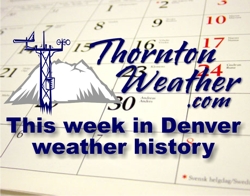
An extremely eventful week in Denver weather history. Most notably for longtime Thornton and Northglenn residents is the 28 year anniversary of the infamous Thornton Tornado which struck on June 3, 1981.
26-31
In 1995…a cool period with light morning showers and moderate to heavy afternoon showers and thunderstorms pushed rivers already swollen from mountain snow melt over their banks causing minor flooding. Streams and rivers such as the South Platte and Boulder creek flooded meadowlands…bike paths…roads near streams…and other low lying areas. No significant property damage was reported and crop damage was unknown. Rainfall totaled 1.79 inches at the site of the former Stapleton International Airport and only 1.51 inches at Denver International Airport.
29-1
In 1894…heavy rain combined with snowmelt runoff caused widespread flooding over the South Platte River basin. Rainfall was heaviest in the foothills where 5 to 8 inches were measured over the 4 days. Heavy rainfall west of Boulder flooded mining towns and damaged mining properties. In the canyons above Boulder…railroads and roads were washed out along with many bridges. The floodwaters spread into central Boulder and covered a wide area from university hill north to near Mapleton Hill to a maximum depth of 8 feet. Many houses were swept away…and every bridge in Boulder was destroyed. A few people…trapped in their homes by the floodwaters… Had to be rescued. However…the gradual rise of the flood waters resulted in only one death. Boulder creek spread to a width of nearly one mile in the pasture land to the east of Boulder. Extensive flooding on left hand creek north of Boulder washed away railroad and wagon bridges. The heavy cloudbursts caused flooding on bear creek…which washed away bridges…railroad tracks…and structures and destroyed the canyon roadway. Morrison sustained the heaviest flood damage on bear creek. In Denver…rainfall totaled only 1.50 inches on the 30th and 31st…but the heavy rainfall on upstream tributaries of the South Platte River caused the river to rise as much as 10 feet above the low water mark in the city…which caused some flooding of pasture land downstream to a depth of 6 feet near Brighton.
30-31
In 1935…heavy thunderstorm rains overnight caused flash flooding east of the city on both Kiowa and Bijou Creeks… Resulting in a total of 9 deaths. Most of the damage was on Kiowa Creek where there were more structures. The water rose rapidly during the storm…ripping houses and stores from their foundations and sweeping them downstream. Precipitation in Denver totaled only 0.01 inch. Hail fell in the city for a short time. The hail was very small and caused no damage.
In 1983…a late storm of rain and snow hit the Front Range. Over an inch of rain fell at some spots…and above 7 thousand feet…1 to 5 inches of snow whitened the ground. Some snow flakes even fell in the western suburbs of metro Denver on the night of the 30th.
In 2002…unseasonably warm weather at the end of the month resulted in 3 temperature records. High temperature of 91 degrees on the 30th equaled the record maximum for the date. Low temperature of 61 degrees on the 31st was a record high minimum for the date. High temperature of 93 degrees on the 31st was a record maximum for the date.
31 in 1917…rainfall totaled 0.55 inch and was mixed briefly with snow around midday. Only a trace of snow fell. Cold temperatures during the day resulted in a high of 44 degrees and a low of 35 degrees. The month closed as the coldest May on record with a mean temperature of only 48.7 degrees…about 8 degrees below normal. The cold temperatures during the month had a marked effect on shade trees and shrubs in the city. Elms were just starting to leaf. Leaves on cottonwoods and maples were only half formed. Lilacs were just blooming…and snowball clusters would not bloom for days.
In 1959…the public reported a tornado briefly touching the ground 10 miles south of Stapleton Airport. No damage was reported.
In 1984…a thunderstorm microburst produced a wind gust to 67 mph…7 miles east of Boulder.
In 1991…hail to golf ball size pummeled southern and southeastern sections of metro Denver and continued on east to Watkins. Several houses and cars were damaged. Later… Thunderstorms dumped heavy rain across the city of Denver… Causing street flooding in an area just south of downtown and just northwest of downtown. Water was up to 10 inches deep over northwest Denver. A brief tornado touched down in Castle Rock where 3/4 inch diameter hail also fell.
In 1993…thunderstorms dropped dime size hail in Commerce City.
In 1994…lightning struck an apartment in Louisville and damaged electronic equipment…including a computer.
In 2006…a severe thunderstorm produced 1 inch diameter hail near Boulder.
Continue reading May 31 to June 6 – This week in Denver weather history

